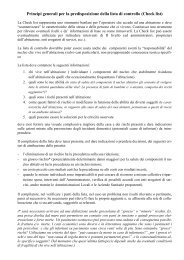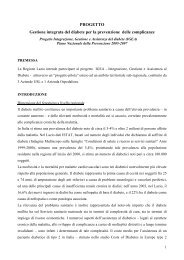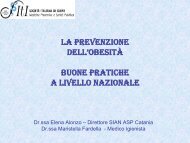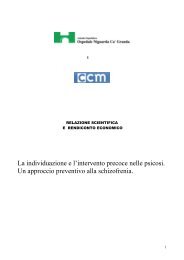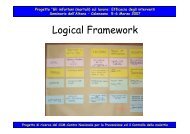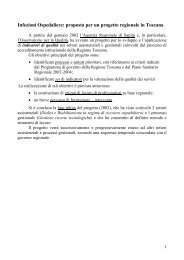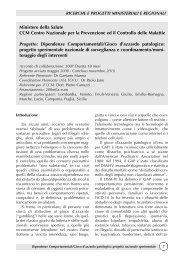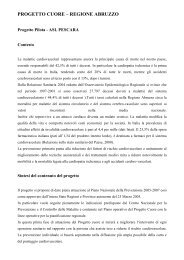Gaining health : analysis of policy development in European ...
Gaining health : analysis of policy development in European ...
Gaining health : analysis of policy development in European ...
Create successful ePaper yourself
Turn your PDF publications into a flip-book with our unique Google optimized e-Paper software.
Chapter 4<br />
42<br />
2.1. Broad <strong>policy</strong> for <strong>health</strong> – Health 2015 public<br />
<strong>health</strong> programme<br />
The current broad <strong>policy</strong> for <strong>health</strong> <strong>in</strong> F<strong>in</strong>land is the Government<br />
resolution on the Health 2015 public <strong>health</strong> programme<br />
(14). This is complemented by Strategies for social protection<br />
2015 – towards a socially and economically susta<strong>in</strong>able society<br />
(15). (A <strong>policy</strong> to tackle <strong>in</strong>equalities <strong>in</strong> <strong>health</strong> is currently<br />
be<strong>in</strong>g prepared by the new Government.) 2<br />
2.1.1. How th<strong>in</strong>gs started<br />
This umbrella <strong>policy</strong> is a cont<strong>in</strong>uation <strong>of</strong> long-term efforts<br />
stemm<strong>in</strong>g from the 1972 law that strengthened the legal<br />
basis for <strong>health</strong> promotion, through the early 1980s when<br />
the Health for All <strong>policy</strong> shifted the focus from <strong>health</strong> care<br />
to <strong>health</strong>. Health 2015 refers directly to the objectives set<br />
<strong>in</strong> the first 1986 Health for All strategy and progress made,<br />
or still to be made, <strong>in</strong> their achievement, and states: “The<br />
WHO’s more recent global Health 21 programme and the<br />
programme for the <strong>European</strong> Region based on it provided<br />
the foundation for F<strong>in</strong>land’s new Health 2015 programme”<br />
(14). The revised Constitution, effective March 2000,<br />
required the Government both to ensure <strong>health</strong> services<br />
and to promote <strong>health</strong>. With this <strong>in</strong> m<strong>in</strong>d, the government<br />
programme states that the promotion <strong>of</strong> the population’s<br />
<strong>health</strong> and functional capacity was to be a factor guid<strong>in</strong>g<br />
all public decision-mak<strong>in</strong>g and activities. Article 152 <strong>of</strong> the<br />
EU Treaty <strong>of</strong> Amsterdam also <strong>in</strong>fluenced this position, and<br />
reference is made to the <strong>in</strong>creas<strong>in</strong>g impact <strong>of</strong> EU decisions<br />
on <strong>health</strong> and the need for a stronger <strong>in</strong>ternational dimension<br />
<strong>in</strong> new <strong>health</strong> <strong>policy</strong> <strong>in</strong>itiatives.<br />
The ma<strong>in</strong> objectives def<strong>in</strong>ed 20 years previously, “to give<br />
people a longer and <strong>health</strong>ier life and to reduce <strong>health</strong> differentials<br />
between population groups”, were seen as still be<strong>in</strong>g<br />
valid. There is, however, one significant shift <strong>in</strong> approach.<br />
2<br />
S<strong>in</strong>ce the completion <strong>of</strong> this case study, a national action plan has been<br />
formulated (16). This is l<strong>in</strong>ked to Health 2015 and <strong>in</strong>cludes actions to<br />
tackle risk factors for NCD such as smok<strong>in</strong>g and alcohol abuse, lack <strong>of</strong><br />
exercise and poor nutrition.<br />
For the 1986 strategy, follow<strong>in</strong>g <strong>in</strong>tensive consultation, it<br />
was decided to set quantified targets only where appropriate:<br />
on scientific grounds ow<strong>in</strong>g to the complexity <strong>of</strong> issues<br />
such as reduc<strong>in</strong>g <strong>in</strong>equalities; and on political grounds s<strong>in</strong>ce<br />
it was thought that politicians would not be comfortable<br />
sett<strong>in</strong>g targets <strong>in</strong> areas over which they had little <strong>in</strong>fluence.<br />
In contrast, Health 2015, based on “research and expert<br />
op<strong>in</strong>ions”, sets quantified targets for improv<strong>in</strong>g the <strong>health</strong> <strong>of</strong><br />
different population groups (children, young people, young<br />
adult men, people <strong>of</strong> work<strong>in</strong>g age and those over 75), plus<br />
targets relat<strong>in</strong>g to the whole population, <strong>health</strong> services, the<br />
environment and reduc<strong>in</strong>g <strong>in</strong>equalities.<br />
Decentralization <strong>in</strong> the plann<strong>in</strong>g and management system<br />
was also said to have led to a reconsideration <strong>of</strong> the use <strong>of</strong><br />
<strong>health</strong> targets <strong>in</strong> <strong>policy</strong>-mak<strong>in</strong>g (17). It was expected that<br />
the targets could only be reached by develop<strong>in</strong>g <strong>health</strong>y<br />
public <strong>policy</strong>, action <strong>in</strong> various sett<strong>in</strong>gs and throughout<br />
the life cycle. Much <strong>of</strong> the action was to come from the<br />
municipal level, which still tended to be <strong>in</strong> a “cutt<strong>in</strong>g mode”<br />
follow<strong>in</strong>g the economic crisis <strong>of</strong> the early 1990s.<br />
2.1.2. Awareness build<strong>in</strong>g and the consultation process<br />
Before turn<strong>in</strong>g to the latest experience, it is helpful to<br />
consider previous consultation efforts. The Health for All<br />
process <strong>in</strong> F<strong>in</strong>land <strong>in</strong> the early 1980s was <strong>in</strong>itiated by lead<strong>in</strong>g<br />
government <strong>of</strong>ficials <strong>in</strong> the <strong>health</strong> field. Although municipal<br />
and pr<strong>of</strong>essional organizations, as well as other sectors,<br />
were <strong>in</strong>volved through sem<strong>in</strong>ars and expert meet<strong>in</strong>gs, “the<br />
exercise rema<strong>in</strong>ed to a large extent a synthesis <strong>of</strong> expert<br />
views on <strong>health</strong> <strong>policy</strong> <strong>development</strong>, which were then<br />
filtered and mangled through the political process” (5). The<br />
draft <strong>policy</strong> was circulated for comments for three months.<br />
The long first draft was considered politically unmanageable,<br />
and a team <strong>in</strong> MSAH led by the M<strong>in</strong>ister reformulated<br />
the report for Parliament <strong>in</strong> 60 pages. The MSAH strategy<br />
that followed was more extensive, with the explicit <strong>in</strong>ten-<br />
Case studies: <strong>policy</strong> <strong>development</strong> <strong>in</strong> countries for tackl<strong>in</strong>g noncommunicable diseases



